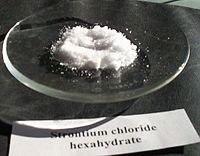| Revision as of 02:25, 20 January 2008 editNeparis (talk | contribs)5,969 edits →Uses: restore informative sentence with added citation to WP:RS; not implying any views on its efficacy as a treatment; please discuss on talk page, rather than edit warring← Previous edit | Revision as of 02:28, 20 January 2008 edit undoජපස (talk | contribs)Extended confirmed users, Pending changes reviewers, Rollbackers60,484 edits Undid revision 185560444 by Neparis (talk) not a reliable source for chemicals... See talk.Next edit → | ||
| Line 83: | Line 83: | ||
| <ref name=Ullmann/> | <ref name=Ullmann/> | ||
| :SrCl<sub>2</sub> + Na<sub>2</sub>CrO<sub>4</sub> → SrCrO<sub>4</sub> + 2 ] | :SrCl<sub>2</sub> + Na<sub>2</sub>CrO<sub>4</sub> → SrCrO<sub>4</sub> + 2 ] | ||
| Strontium chloride is occasionally used as a flame colouring agent (red) in ], and in small quantities in ] making and ]. The ] ] strontium-89 is usually administered in the form of strontium chloride: it is used for the treatment of ]. Sea water aquaria require small amounts of strontium chloride, which is consumed in the production of the ]s of certain ]. |
Strontium chloride is occasionally used as a flame colouring agent (red) in ], and in small quantities in ] making and ]. The ] ] strontium-89 is usually administered in the form of strontium chloride: it is used for the treatment of ]. Sea water aquaria require small amounts of strontium chloride, which is consumed in the production of the ]s of certain ]. | ||
| | author=Scholten, J | |||
| | title=Homeopathy and the Elements | |||
| | publisher=Stichting Alonnissos: Utrecht | |||
| | year=1996 | |||
| | isbn=907481705X | |||
| | pages=543-547}}</ref> | |||
| ===Dental care=== | ===Dental care=== | ||
Revision as of 02:28, 20 January 2008
 Strontium chloride hexahydrate | |
| IUPAC name Strontium chloride | |
| General | |
|---|---|
| Molecular formula | SrCl2 |
| Molar mass | 158.53 g/mol (anhydrous)
266.62 g/mol (hexahydrate) |
| Appearance | White crystalline solid |
| CAS number | (hexahydrate)
(anhydrous) |
| MSDS | Strontium chloride MSDS |
| Other names | |
| |
| Bulk properties | |
| Density | 3.052 g/cm³ (anhydrous, monoclinic form) |
| Solubility | water: 53.8 g/100 cm³ (20 °C)
ethanol: very slightly soluble acetone: very slightly soluble |
| Melting point | 874 °C (1147 K) |
| Boiling point | 1250 °C (1520 K) |
| Hazards: | Irritant |
| Structure | |
| Coordination geometry | octahedral (six-coordinate) |
| Crystal structure | Deformed TiO2 |
| Hydrates | dihydrate (rare)
hexahydrate |
| Related compounds | |
| strontium fluoride | calcium chloride |
Strontium chloride (SrCl2) is a salt of strontium and chlorine. It is ionic and water-soluble. It is less toxic than barium chloride, though more toxic than calcium chloride. Like all compounds of Sr, this salt emits a bright red colour in a flame and in fact is used as a source of redness in fireworks. Otherwise strontium chloride is a typical salt, forming neutral aqueous solutions.
Preparation
Strontium chloride can be prepared from strontium hydroxide or strontium carbonate reacting with hydrochloric acid:
From aqueous solution, one obtains the hexahydrate, SrCl2·6H2O. Dehydration occurs in stages, commencing above 61 °C. Full dehydration occurs at 320 °C.
Uses
No major uses exist for strontium chloride. It is the precursor to other compounds of strontium, such as and it can be used as a source of other strontium compounds such as yellow strontium chromate, which is used as a corrosion inhibitor for aluminium. The precipitation proceeds analogously to the related sulfate:
- SrCl2 + Na2CrO4 → SrCrO4 + 2 NaCl
Strontium chloride is occasionally used as a flame colouring agent (red) in pyrotechnics, and in small quantities in glass making and metallurgy. The radioactive isotope strontium-89 is usually administered in the form of strontium chloride: it is used for the treatment of bone cancer. Sea water aquaria require small amounts of strontium chloride, which is consumed in the production of the exoskeletons of certain plankton.
Dental care
SrCl2 is useful in reducing gum sensitivity and periodontal disease. Known in the US as Elecol and Sensodyne, these products are called "strontium chloride toothpastes," although most now use potassium nitrate instead (with the exception of "Sensodyne original").
References
- ^ J. Paul MacMillan, Jai Won Park, Rolf Gerstenberg, Heinz Wagner, Karl Köhler, Peter Wallbrecht"Strontium and Strontium Compounds" in Ullmann's Encyclopedia of Industrial Chemistry, 2005 Wiley-VCH: Weinheim. DOI 10.1002/14356007.a25 321